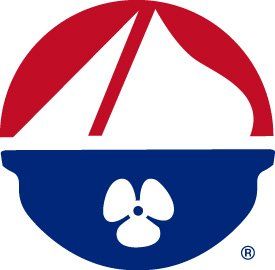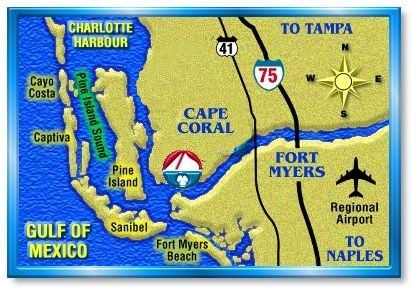


Hi-diddly-dee, the sailor's life for me...
Standing at the helm of the good ship
Blue
Note , a 36-foot Grand Banks trawler, I certainly
look the quintessential image of a seafaring captain.
Boat shoes? Check. Cool captain's cap? Check.
A bit of salt spray on my brow? Check, check,
check.
Ah, the life of the sea. A man, his boat and...
"Now let's see you put her in the slip," says Capt. Christopher Day, pointing to a pair of tall pilings just off the seawall along a canal leading to the Caloosahatchee River. The pilings appear to be standing about 12 feet apart. And, just guessing, I'd say the Blue Note is about, oh, 152 feet wide. Actually, as we nautical types say, it has a 10-foot beam. It's just that at this particular moment, considering the task at hand, the boat seems a whole lot wider.
"You mean put this big boat in that tiny little slip right there?"
"Yeah," says Day. "Don't forget to take the current into consideration. Looks like the tide's outgoing right now. And the wind. Got a pretty good wind from the south. Just back 'er on in."
I eye the slip again. The opening between the pilings seems even narrower, the boat even beamier.
"You gotta be kidding."
"If you want to be a captain, you have to know how to dock your boat," says Day. "Don't worry, it'll fit."
Yeah, it'll fit. But not with this poser at the helm.
A few salient facts about boating in Southwest Florida, the boat-lovingest region in the entire state: Lee County, with some 42,000 registered vessels, has more boats per capita-about one for every 12 people- than any Florida county. And with about 19,000 registered boats, or one for every 14 people, Collier County ranks just behind it. By comparison, Dade County boats only one boat for every 42 of its residents, Palm Beach one for every 32.
Now, here are the troubling statistics: With seven boater deaths in 2001, not to mention 23 manatees killed by boats, Lee County's waters were among the most dangerous in the state.
"There's no argument that Southwest Florida with its barrier islands and its miles and miles of waterways boasts some of the best cruising grounds, not just in Florida, but in the world," says Barb Hansen. "Everyone who moves down here wants to buy a boat and get out and enjoy it. But not everyone knows what they're doing in a boat."
And that's being diplomatic. Truth is, too many boat owners are outright hazards on the waterway. Barb tells a story about being out on Pine Island Sound one afternoon and coming across a boat that had lost its way. The man and woman in the boat were studying a map.
"But it was a AAA road map, not a nautical chart," says Barb. "They didn't have a clue."
So many boats, so many clueless boaters. Which is one reason why Hansen and her husband, Vic, started their North Fort Myers based Florida Cruising and Sailing School more than 18 years ago. Since then, hundreds of prospective captains from all over the world have signed on to hone their nautical skills. With 13 different courses run from its sailing school at Burnt Store Marina on Charlotte Harbor and a dozen powerboat courses offered at its headquarters at Marinatown Marina on the Caloosahatchee, the school aims not just to make the waterways safer, but to help boat lovers get full enjoyment out of their craft.
"You can't enjoy your boat if you can't relax on it," says Barb. "And you can't relax if you don't have confidence. We teach confidence."
The types of courses range from basic sailing and bareboat charter to coastal navigation, inland powerboat cruising and offshore powerboat cruising. An entry-level "Safe Boating 101" course teaches boating terminology, chart reading and seamanship. A "First Mate" course, which offers instruction in the skills needed to act as crew on a cruising boat, is popular with spouses and children of boat owners.
The school is also a good starting point for people who are deciding if the boating life is really for them. Typical example: A couple buys a home in Southwest Florida and decides they want a big powerboat to go with it, something they can take on trips to Key West or the Bahamas. They've had smaller boats in the past, know their way around the water and think they are ready to move up a notch or two. So they sign on for the school's eight-day "Offshore Powerboat Cruising Course," which includes preparing and provisioning for a roundtrip voyage to the Florida Keys, along with offshore navigation, night passagemaking, ship's maintenance and dozens of other tasks, all under the guidance of a U.S. Coast Guard-licensed captain/instructor.
"Most people find they love it. But every now and then we get a couple who completes the trip, gets off the boat and says: 'Nope, that's not for us.' They hadn't anticipated what it's like spending a week on a boat with other people, which not everyone is cut out for," says Barb. "But it's better that people learn that up front than after they've spent several hundred thousand dollars on the boat of their dreams."
"Easy now, easy," says Day as I maneuver Blue Note toward its berth. "The secret it to always go slow."
Gee, thanks for that hint, Christopher. But what's the secret when the boat won't go in the direction I want it to go? Blue Note has twin screws-fancy nautical talk for propellers-and I'm having a heck of a time figuring out which prop turns the boat which way. And it's complicated by the fact that the boat is going backward into its slip.
"You're coming up close on that starboard piling. Easy, easy," says Day. "Swing the stern to port."
I push the port-engine throttle forward. Bad move. The Blue Note's stern swings starboard and grazes the piling. Day grabs the wheel.
"Let's try that again from the top," he says.
To get a taste of what the Florida Sailing and Cruising School has to offer, I signed on for an outing with Day, a sort of crash course as it were. A former history teacher and a native of Great Britain, Day has been knocking about on boats for most of his life, and started teaching at the school after his arrival in Southwest Florida about five years ago .
"First," he tells me, "we will acquaint ourselves with all the holes in the boat,"
Holes in the boat? Not the sort of thing that breeds confidence.
"I always like to start off with the holes because what's the worst thing that can happen if you're on a boat?" he asks.
"It sinks," I say,
"And why does the boat sink?"
"Because it has too much water in it."
"Exactly," says Day. "So we begin with checking out all the ways in which water can get in and out of this boat."
As it turns out, there are one heckuva lot of holes in Blue Note -holes that control the flow from the bilge, holes that regulate the air conditioner's runoff, holes from the head and holes from the galley. After we're done checking out the holes, we head for the control panel and ID all the switches and gauges. Day taps the glass face of one of the gauges.
"Very important instrument, particularly here in Southwest Florida," he says. "It's the depth sounder. Number one problem with new boaters in the area-running aground. Even a problem with boaters who think they know the water. There are only about a million places to run aground around here. Always keep an eye on the depth sounder."
After opening a hatch in the cabin floor and examining the engine room-a spic n' span cavern that houses twin 135 horsepower Ford Lehman diesels- we finally cast off and head along a narrow channel to the Caloosahatchee. Once in the main channel, Blue Note chugs along between six and eight knots, heading for the mouth of the river and a small island where we'll have lunch.
It's a 90-minute haul, which gives Day plenty of time to expound upon such topics as rules of right-of-way, how to read channel markers, and how to read nautical charts so you don't run aground and have to pay the Sea Tow several hundred dollars to pull you free. And when we get ready to drop anchor off the island, well, that's a whole 'nother lesson in seamanship.
But there's also plenty of time to just kick back, relax and remember why you're on the boat in the first place-to get the heck away from it all, to soak up the great wide open. A mother dolphin and her baby draft the bow.. A giant stingray sails out of the water ahead. Ospreys plunge from their roosts to grab fish.
I take the wheel of Blue Note as we head back to the marina, feeling cocky, feeling good. Yeah, I've got this captain thing under control. Piece of cake. Yo-ho-ho and all that. No problem.
Until I pull into the narrow channel. And Day tells me I have to dock the damn thing.
It's the third try and I think I've finally got the hang of this docking thing. The secret is to "walk" the boat backwards, jockeying the port and starboard engine throttles so that Blue Note sorta crabs its way into the slip.
I squeeze her past the pilings with inches to spare. Day and the crew cast off lines and snug the boat to the pilings and cleats on the seawall.
Yes, my work here is done. Day offers his hand.
"Congratulations, captain,"
he says. "Because there's nothing more embarrassing
than sinking your boat at the slip."
Sign up for updates!
Thank you for signing up.
Oops, there was an error joining.
Please try again later



